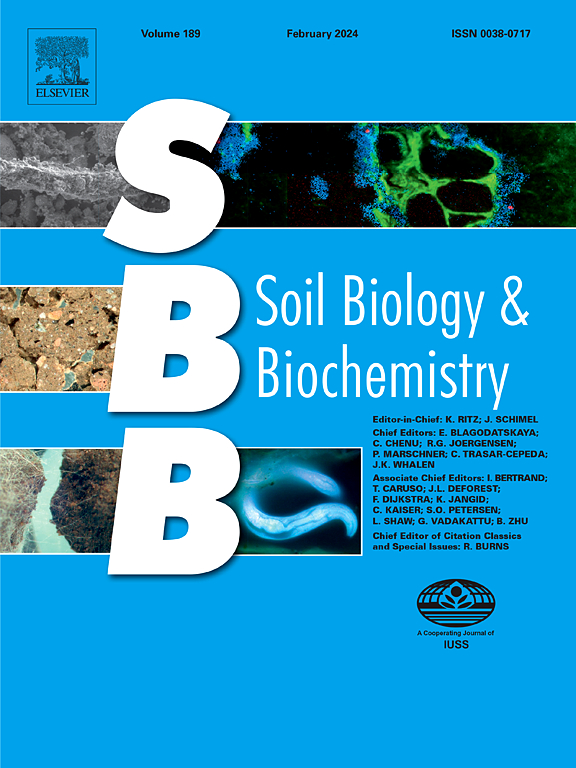Patterns and drivers of soil autotrophic nitrification and associated N2O emissions
IF 9.8
1区 农林科学
Q1 SOIL SCIENCE
引用次数: 0
Abstract
Soil autotrophic nitrification, driven by ammonia oxidizers, is critical for providing plant-available nitrogen (N). However, it can also lead to N losses and environmental degradation under certain conditions. While numerous studies have examined autotrophic nitrification at individual sites, there is a lack of broad-scale, systematic investigations across diverse biomes, soil types, and climatic conditions. To address this gap, we analyzed data from 52 studies that used shaken slurry or aerobic incubation experiments that used chemical inhibitors (1-octyne and acetylene) to distinguish autotrophic nitrification driven by different taxa of ammonia oxidizers. Our analysis showed significant variation in nitrification rates, N2O emissions, and N2O yield across different ecosystems and fertilizer types. Croplands and soils treated with organic fertilizers exhibited the highest risk of N losses, whereas partially substituting mineral fertilizers with organic fertilizers showed the potential in reducing this risk. The observed inconsistent variations in autotrophic nitrification rates and N2O emissions are likely due to changes in N2O yield. Optimal temperatures for autotrophic nitrification were higher for ammonia-oxidizing archaea than for ammonia-oxidizing bacteria and varied across ecosystems and fertilizer types, reflecting the unique environmental conditions shaping ammonia oxidizer communities. The abundance of ammonia oxidizers was the primary factor regulating total autotrophic nitrification rates. Based on these findings, we suggest two strategies to control autotrophic nitrification: reducing substrate availability by incorporating organic or mixed fertilizers and applying nitrification inhibitors. In conclusion, this study provides a comprehensive overview of soil autotrophic nitrification across a broad range of conditions, contributing to a deeper understanding of soil N dynamics and informing nutrient management strategies to reduce N losses and environmental pollution.
土壤自养硝化和相关N2O排放的模式和驱动因素
由氨氧化剂驱动的土壤自养硝化作用对提供植物速效氮至关重要,但在一定条件下也会导致氮素损失和环境退化。虽然已有大量研究考察了单个地点的自养硝化作用,但缺乏对不同生物群系、土壤类型和气候条件进行大规模、系统的调查。为了解决这一差距,我们分析了52项研究的数据,这些研究使用摇浆或使用化学抑制剂(1-辛烷和乙炔)的好氧培养实验来区分由不同氨氧化剂类群驱动的自养硝化。我们的分析表明,在不同的生态系统和肥料类型中,硝化速率、N2O排放和N2O产量存在显著差异。施用有机肥的农田和土壤氮素流失风险最高,而用有机肥部分替代矿物肥则有可能降低这一风险。观察到的自养硝化速率和N2O排放量的不一致变化可能是由于N2O产量的变化。氨氧化古菌的最适自养硝化温度高于氨氧化细菌,且在不同的生态系统和肥料类型中存在差异,反映了形成氨氧化菌群落的独特环境条件。氨氧化剂丰度是调节总自养硝化速率的主要因素。基于这些发现,我们提出了两种控制自养硝化的策略:通过添加有机或混合肥料来降低基质有效性和施用硝化抑制剂。综上所述,本研究提供了广泛条件下土壤自养硝化的全面概述,有助于深入了解土壤N动态,并为养分管理策略提供信息,以减少N损失和环境污染。
本文章由计算机程序翻译,如有差异,请以英文原文为准。
求助全文
约1分钟内获得全文
求助全文
来源期刊

Soil Biology & Biochemistry
农林科学-土壤科学
CiteScore
16.90
自引率
9.30%
发文量
312
审稿时长
49 days
期刊介绍:
Soil Biology & Biochemistry publishes original research articles of international significance focusing on biological processes in soil and their applications to soil and environmental quality. Major topics include the ecology and biochemical processes of soil organisms, their effects on the environment, and interactions with plants. The journal also welcomes state-of-the-art reviews and discussions on contemporary research in soil biology and biochemistry.
 求助内容:
求助内容: 应助结果提醒方式:
应助结果提醒方式:


